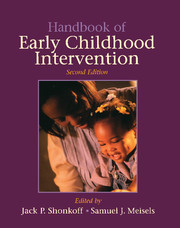Book contents
- Frontmatter
- Contents
- Foreword
- Preface
- Contributors
- PART ONE INTRODUCTION
- PART TWO CONCEPTS OF DEVELOPMENTAL VULNERABILITY AND RESILIENCE
- PART THREE THEORETICAL FRAMEWORKS FOR INTERVENTION
- PART FOUR APPROACHES TO ASSESSMENT
- 11 The Elements of Early Childhood Assessment
- 12 Assessment of Parent–Child Interaction: Implications for Early Intervention
- 13 Family Assessment Within Early Intervention Programs
- 14 Measurement of Community Characteristics
- PART FIVE SERVICE DELIVERY MODELS AND SYSTEMS
- PART SIX MEASURING THE IMPACT OF SERVICE DELIVERY
- PART SEVEN NEW DIRECTIONS FOR THE TWENTY-FIRST CENTURY
- Name Index
- Subject Index
14 - Measurement of Community Characteristics
Published online by Cambridge University Press: 05 November 2011
- Frontmatter
- Contents
- Foreword
- Preface
- Contributors
- PART ONE INTRODUCTION
- PART TWO CONCEPTS OF DEVELOPMENTAL VULNERABILITY AND RESILIENCE
- PART THREE THEORETICAL FRAMEWORKS FOR INTERVENTION
- PART FOUR APPROACHES TO ASSESSMENT
- 11 The Elements of Early Childhood Assessment
- 12 Assessment of Parent–Child Interaction: Implications for Early Intervention
- 13 Family Assessment Within Early Intervention Programs
- 14 Measurement of Community Characteristics
- PART FIVE SERVICE DELIVERY MODELS AND SYSTEMS
- PART SIX MEASURING THE IMPACT OF SERVICE DELIVERY
- PART SEVEN NEW DIRECTIONS FOR THE TWENTY-FIRST CENTURY
- Name Index
- Subject Index
Summary
Because studying social contexts is arduous and expensive, it is crucial to have both a theoretical and a practical commitment to take on the challenge of measuring community properties with a sense of precision and accuracy. The material covered in this chapter addresses two concerns. While not the primary purpose, the first regards the rationale for studying communities. The second and more central issue regards how to do it. Following the theoretical contributions of Lewin (1954) and Bronfenbrenner (1979), and the empirical approach of Barker and Wright (1949), there has been a rebirth and intensification of interest in community and neighborhood effects on a host of developmental outcomes: from low birth weight and intelligence to rates of high school graduation and violent crime (Brooks-Gunn, Klebanov, & Duncan, 1996; Ensminger, Lamkin, & Jacobson, 1996). As is noted, this research is still in its early phases of evolution, and several methodological and analytical challenges remain to be solved and incorporated systematically into programs of research. By the same token, interventions that are aimed at community-level influences are seldom based on scientifically based information and experience. Commenting on the challenges faced by community-based initiatives, Rosewater noted, “It is clear that the activities are … outstripping their intellectual and conceptual frameworks. If the initiatives are to fulfill their promise there is a need to sharpen thinking about community development on the one hand, meeting the needs of children and families on the other hand, and the connections between the two” (cited in Aber, 1995, p. 264).
- Type
- Chapter
- Information
- Handbook of Early Childhood Intervention , pp. 309 - 324Publisher: Cambridge University PressPrint publication year: 2000
- 8
- Cited by

